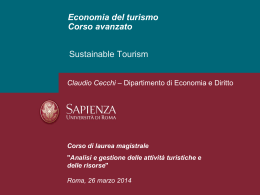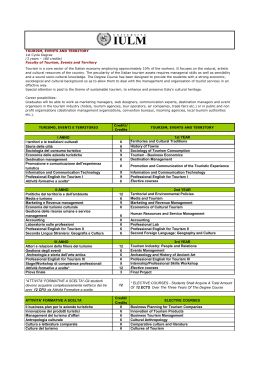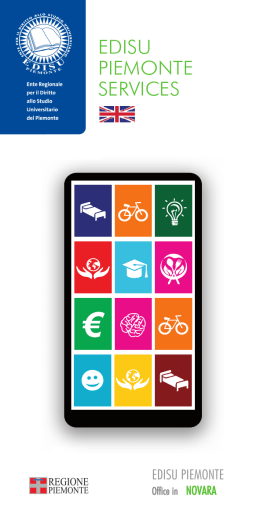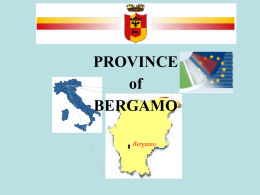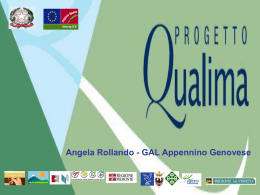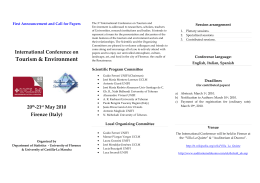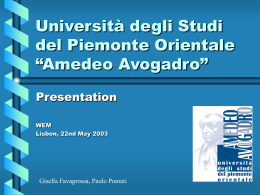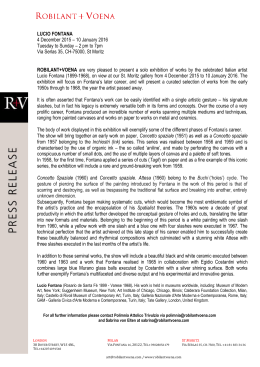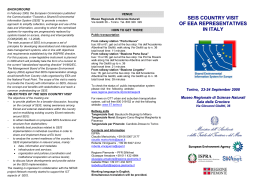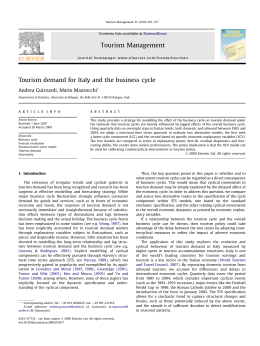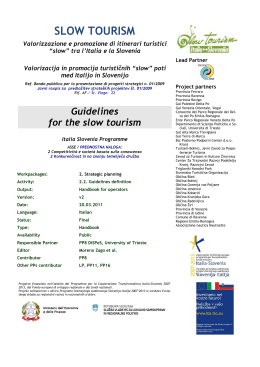93 Statistica Applicata Vol. 20, n. 2, 2008 THE USE OF CORRESPONDENCE ANALYSIS TO STUDY DAILY TOURISM FLOWS Roberto Fontana Politecnico di Torino, Dipartimento di Matematica e-mail: [email protected] Abstract The paper describes how correspondence analysis could be useful to analyze daily tourism flows. An animated graph of the symmetric plot is generated. It can help operators in having a quick view of tourism dynamics. Real data from Regione Piemonte are used to describe the methodology. Keywords: Tourism statistics, Official Statistics, Statistical methods, Correspondence Analysis. INTRODUCTION ISTAT, the Italian National Statistical Institute, collects monthly data on tourism flows that are registered in the Italian accommodation structures. This activity is a census that directly involves all the Italian accommodation structures. From an operational point view, the data collection process is supported by the provincial and the regional offices. In particular, with respect to Regione Piemonte, one of the Italian Regions1, the collection process is carried on by the eight provincial statistical offices under the supervision of the Direzione Cultura, Turismo e Sport della Regione Piemonte with the support of the Osservatorio Turistico della Regione Piemonte (OTRP). Since the end of 2007, a new on-line web based service (TUAP), has been made available to the accommodation structures of Piemonte. Now, using the internet, each accommodation structure can provide its data on a daily basis instead of on a monthly basis. 1 Regions are the first-level administrative divisions of the Italian state. 94 Fontana R. As we will show in the next sections, around 10% of all the accommodation structures have used TUAP during 2008 so providing their data on a daily basis. The availability of this dataset opens the way to the possibility to investigate the impact of events and holidays on tourism flows but also to study the dynamics of tourism at more detailed time scale. THE AVAILABLE DATA OTRP provided a database containing all the daily time series that have been collected in 2008. This database contains the time series of 502 accommodation structures (there were 4.823 structures in 2008 in Piemonte). The time series of bednights2, one of the most important indicator to analyze tourism performance, have been considered in this work. It’s well known to the operators that, from a point of view of tourism, Piemonte cannot be considered as an homogenous area. Indeed its territory is usually partitioned into five areas: 1. Metropolitan Areas, including Turin and medium sized towns, 2. Lakes, a beautiful natural district in north-east of Piedmont, close to Switzerland and Milan, 3. Mountains, including the famous skiing resorts of the Winter Olympic Games, 4. Hills, where food and wine are the key feature of the offer, 5. Other, a small category that contains all the remaining areas for which one of the previous definition does not apply. These areas are often referred by the operators as products. Using the available data, it was possible to split the total of bednights of each day of 2008 into five subtotals, one for each of the previous five products. We obtain a dataset with 366 rows (2008 was a leap year) and 5 columns whose first and last rows are reported into the following Table 1. 2 1 bednight is equal to 1 night spent at an accommodation unit by 1 person 95 The use of correspondence analysis to study daily tourism flows Tab. 1 Metropolitan DAY Other Area Hills Lakes Mountains 1/1 115 613 122 22 1887 2/1 141 718 62 24 1676 3/1 162 742 70 22 1651 4/1 127 590 45 15 1690 … … … … … … … … … … … … … … … … … … 28/12 117 890 341 67 1543 29/12 151 1018 181 102 1632 30/12 158 1155 215 106 2020 31/12 292 1412 475 175 2992 THE USE OF CORRESPONDENCE ANALYSIS TO STUDY TOURISM FLOWS The previous dataset reports the classification of each bednight with respect to the day and to the area in which it has been registered. We can analyze these data using standard correspondence analysis (Dillon and Goldstein, 1984; Greenacre, 1993; Rapallo and Rogantin; 2003, Rencher; 1995). With the procedure CORRESP of the software SAS, we obtain the output in Table 2. Tab. 2: The CORRESP Procedure. Inertia and Chi-Square Decomposition Singular Principal Chi- Percent Value Inertia Square Percent Cumulative 12 24 36 48 60 ----+----+----+----+----+---0.34550 0.11937 161349 61.57 61.57 ************************** 0.24428 0.05967 80653 30.77 92.34 ************* 0.09761 0.00953 12879 4.91 97.25 ** 0.07297 0.00532 7197 2.75 100.00 * 262078 100.00 Total 0.19 Degrees of Freedom = 1460 96 Fontana R. As we can see from Table 2, if we limit to two dimensions, we represent 92% of the total inertia. The accuracy increases to 97% with three dimensions. Tab. 3: The CORRESP Procedure. Summary Statistics for the Column Points Quality Mass Inertia Other 0.6227 0.0848 0.0685 Metropolitan areas 0.9383 0.4191 0.1889 Hills 0.5016 0.0794 0.0735 Lakes 0.9911 0.138 0.2509 Mountains 0.9995 0.2780 0.4181 If we work with two dimensions, we obtain the statistics reported in Table 3. We observe that the quality of representation of Other (62%) and Hills (50%) is not very high. It becomes better, in particular for Hills (91%), if we increase to three dimensions as we can see from the following Table 4. Tab. 4: The CORRESP Procedure. Summary Statistics for the Column Points Quality Mass Inertia Other 0.7273 0.0848 0.0685 Metropolitan areas 0.9933 0.4191 0.1889 Hills 0.9116 0.0794 0.0735 Lakes 0.9964 0.1387 0.2509 Mountains 0.9998 0.2780 0.4181 Therefore we decide to work with three dimensions and we repeat the same analysis for the row profiles, i.e. for the days. We still obtain very good results. More than 70% of days have a quality of representation greater than 96% and only 4 days out of 366 have a quality of representation less than 70%, as it appears in Figure 1. 97 The use of correspondence analysis to study daily tourism flows Fig. 1. If we analyze how the days are represented into the 3-dimensional space, referring to Table 2 and to the following Figure 2, we obtain: • the first dimension (Dim1, that explains the 61.57% of the total inertia) discriminates between spring/autumn (high values of Dim1) and winter/summer (low values of Dim1), • the second dimension (Dim2, that explains the 30.77% of the total inertia) discriminates between summer (high values of Dim2) and the remaining seasons, • high values of Dim3 are for days in October (Dim3 explains only 4.91% of the total inertia). Di m 1 0. 9 D im 2 0. 9 D im 3 0. 9 0. 8 0. 8 0. 8 0. 7 0. 7 0. 7 0. 6 0. 6 0. 6 0. 5 0. 5 0. 5 0. 4 0. 4 0. 4 0. 3 0. 3 0. 3 0. 2 0. 2 0. 2 0. 1 0. 1 0. 0 0. 0 0. 0 - 0. 1 - 0. 1 - 0. 1 - 0. 2 - 0. 2 - 0. 3 - 0. 3 - 0. 4 - 0. 4 - 0. 5 - 0. 5 - 0. 6 - 0. 6 - 0. 2 - 0. 3 - 0. 4 - 0. 5 - 0. 6 - 0. 7 - 0. 7 - 0. 8 - 0. 7 - 0. 8 - 0. 9 01JAN 0. 1 - 0. 8 - 0. 9 01FEB 01M AR 01APR 01M AY 01JUN 01JUL Day Fig. 2. 01AUG 01SEP 01O CT 01NO V 01DEC 01JAN 01JAN - 0. 9 01FEB 01M AR 01APR 01M AY 01JUN 01JUL Day 01AUG 01SEP 01O CT 01NO V 01DEC 01JAN 01JAN 01FEB 01M AR 01APR 01M AY 01JUN 01JUL Day 01AUG 01SEP 01O CT 01NO V 01DEC 01JAN 98 Fontana R. If we now analyze how the products are represented into the 3-dimensional space, with respect to the following Figure 3, we obtain that • Mountains are characterized by low values of Dim1 • Other and Metropolitan Areas are characterized by high values of Dim1 • Hills are characterized by high values of Dim1 and high values of Dim3 • Lakes are characterized by high values of Dim2 Fig. 3. If we combine the analysis of row profiles with that of column profiles we obtain some interesting results: • Metropolitan Areas, Hills and Other distinguish themselves from Lakes and Mountains for registering high volumes of incoming tourism flows during spring and autumn; October, in particular, is characteristic for Hills. The use of correspondence analysis to study daily tourism flows 99 • Mountains, on the contrary, point out for their performances during winter and summer. • Finally, summer is the key season for Lakes. Fig. 4. AN ANIMATED SYMMETRIC PLOT To better describe the dynamics of tourism flows during the year 2008, we build the symmetric plot (Rapallo and Rogantin; 2003, in which both the standardized column and row profiles are represented (Figure 4). This plot is often used even if it should be taken into account that distances between row and column points are not defined. In Figure 4 column profiles correspond to balls while row profiles to pyramids, apart from the four days that have a quality of representation less than 70%, that are shown as cubes. 100 Fontana R. Each day is labeled with “d/m” where d is the day and m is the month (e.g. ‘3/ 2’ means 3 of February). In order to facilitate the discussion with operators that work in the tourism sector, we observed that we can get a nice view of how tourism flows move between the different products if we remind that the rows are subsequent days of one year and columns are geographical areas. We can generate an animation of the symmetric plot where each row profile is placed in the graph one-at-a-time (http:// calvino.polito.it/~fontana/corresp3d-english.htm). Following how the red point (day) moves among the blue balls (products), we get a true movie that describes when tourists mainly prefer a certain area. For example it becomes evident the role of Mountains in winter and summer and the food and wine season for Hills in late September and October. SOFTWARE All the statistical analysis, including the generation of the animated graph, has been performed with SAS, (SAS Institute Inc., 2004). CONCLUSION Correspondence analysis has been applied to compare bednights time series that correspond to different geographical areas. The animated symmetric plot revealed a powerful tool to describe the tourism dynamics, as we experienced during the talk given at the conference “Il turismo: risorsa economica anticrisi” that was held in Turin on 25 June 2009. The methodology and the software are well established and the kind of data are of general interest so the proposed approach could be of potentially wide use. ACKNOWLEDGMENTS The present paper is an output of the “Analisi statistica dei flussi turistici” project, carried on by the Department of Mathematics of Politecnico di Torino and funded by Sviluppo Piemonte Turismo (Torino). The author wishes especially to thank Giovanni Pistone (Politecnico di Torino) for his helpful hints and suggestions. The author also thanks Marzia Baracchino (Direzione Cultura, Turismo e Sport della Regione Piemonte), Cristina Bergonzo, Livia Falomo e Maria Elena Rossi (Sviluppo Piemonte Turismo) for their continuous cooperation and Valeria Varetti (Politecnico di Torino) for her The use of correspondence analysis to study daily tourism flows 101 support in software development. Finally the author thanks Daniela Formento, director of the Direzione Cultura, Turismo e Sport della Regione Piemonte for having provided to the Politecnico research group the direct access to the database (individual data). REFERENCES DILLON W. and GOLDSTEIN M. (1984). Multivariate Analysis: Methods and Applications. John Wiley & Sons. GREENACRE M. J. (1993). Correspondence Analysis in Practice. Academic Press, Harcourt, Brace & Company. RAPALLO F., ROGANTIN M.P. (2003). Statistica Descrittiva Multivariata, Seconda edizione. CLUT RENCHER A.C. (1995). Methods of Multivariate Analysis, John Wiley & Sons. SAS Institute Inc. (2004). SAS/Stat Æ 9.1 User’s Guide. Cary, NC: SAS Institute Inc. L’USO DELL’ANALISI DELLE CORRISPONDENZE PER STUDIARE I FLUSSI TURISTICI GIORNALIERI Riassunto L’articolo descrive l’applicazione dell’analisi delle corrispondenze ai flussi turistici giornalieri. E’ stata, in particolare, realizzata un’animazione del symmetric plot, che costituisce uno strumento utile nell’illustrare agli operatori, in modo semplice ed intuitivo, la dinamica turistica. La metodologia è stata sperimentata su dati reali, relativi alle presenze turistiche registrate presso le strutture ricettive del Piemonte.
Scarica


